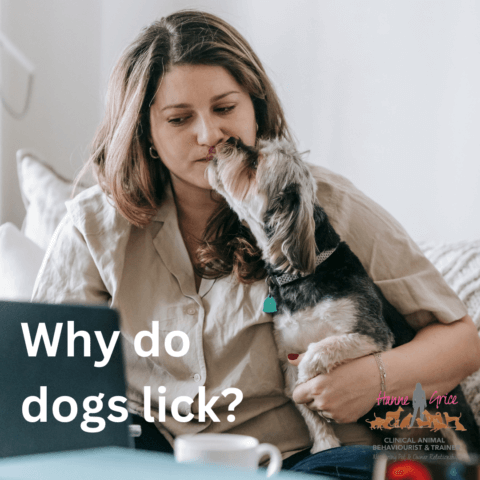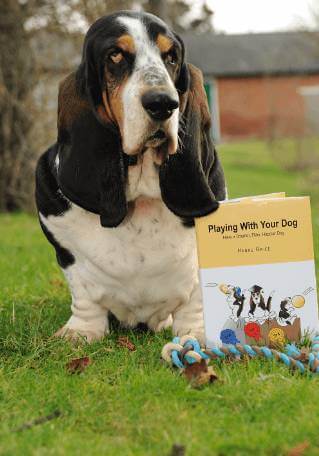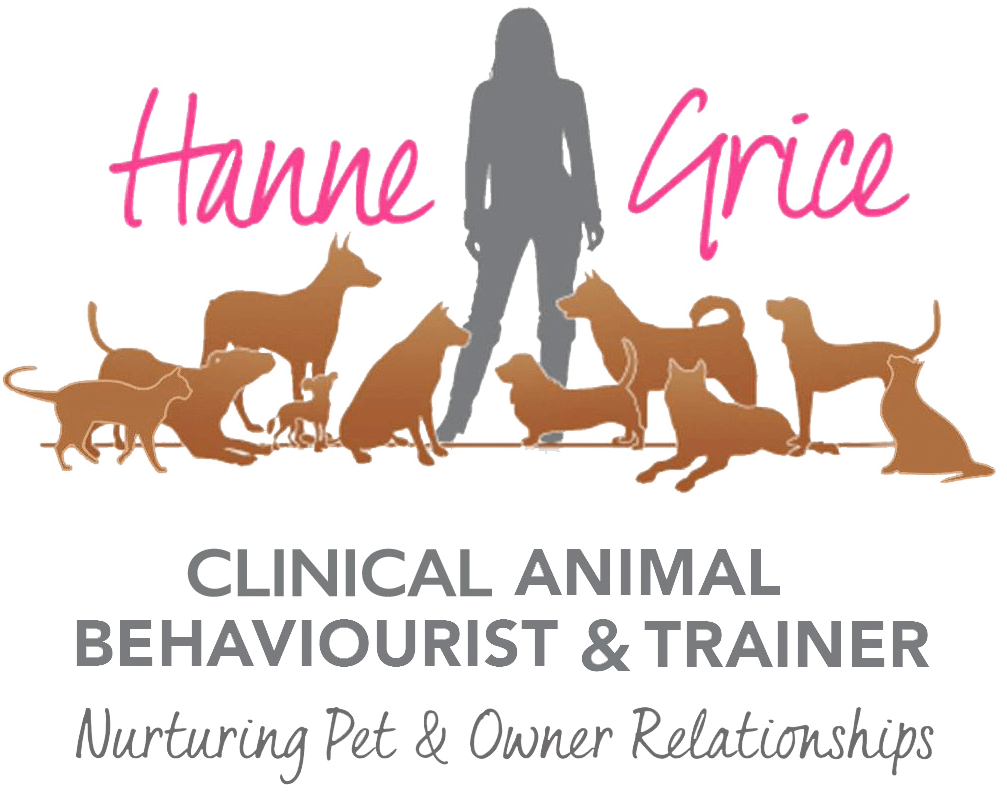
As dog owners/guardians, we frequently observe our furry friends engaging in the universal dog behaviour: licking. But have you ever paused to ponder the multifaceted reasons behind this common canine behaviour? Why do dogs lick?
While licking is a regular occurrence, it arises from various motivations rooted deeply in dogs’ physiology, evolutionary history, and emotional states. For a quick overview, check the ‘Diagnostic differentials for licking’ table at the end of this article.
The origins…
From an evolutionary standpoint, it’s suggested that licking has deep roots going back to the domestic dog’s wild ancestors. Initially, puppy wolves would lick the faces of adult wolves to encourage regurgitation, an essential aspect of their feeding habits during their early stages (Serpell, 1995). It’s thought that this innate behaviour has carried over to pet dogs, explaining why puppies often lick their mothers, adult dogs, and their humans.
Functions of licking
Aside from its historical background, dogs maintain their hygiene through licking. It serves as part of their cleanliness routine as well as a mechanism to cool down, as the evaporation of saliva aids in reducing body temperature (Horowitz, 2017).
Licking also releases endorphins, which helps provide dogs with a sense of comfort, as well as pleasure. In addition, licking is also part of the dog’s greeting ritual – like shaking someone’s hand, so licking can help dogs build a bond with their carers (Bekoff, 2009).
However, licking isn’t just an affectionate gesture; it’s a tool for gathering information. Dogs have a heightened sense of taste and smell, which allows them to obtain detailed information about their environment and the individuals they interact with (McGreevy et al., 2015).
And, licking may also be used as a way to create space from another. For example, trainer Jennifer Shryock refers to this as a “kiss to dismiss”. For example, when the well-meaning visitor leans into the dog’s face, the dog may attempt to lick – the sight of a big wet tongue looming towards them, may cause the visitor to repel to avoid getting slobbered with salvia. The space created by the person moving away can be rewarding to the dog, so the licking behaviour is repeated in similar contexts. This is a subtle cue to communicate a need for space or to end a less welcome engagement.
Some dogs lick because they have learned it creates a big, warm reaction from some, so the attention gained from their handler when the dog licks is highly rewarding. Hence, licking can be a learned behaviour for gaining attention; if your pet has realised that licking earns them affection/treats, etc., they might adopt this as a standard method to catch your attention (Herron et al., 2008).
In some instances, licking can be a manifestation of underlying anxiety, stress, and or pain/discomfort linked to various medical issues such as gastrointestinal, and even hormonal balances. Therefore, dogs may resort to licking as a way to alleviate anxiety or any pain/discomfort (Landsberg et al., 2012). Engaging in this familiar activity offers them a calming effect, helping them cope with environmental stressors (Dreschel and Granger, 2005). As pet carers, it’s crucial to be cognisant of the contexts in which licking occurs, and by observing your dog’s other body language signals that accompany licking, we an gain insights into the underlying emotions likely prompting this behaviour (Mariti et al., 2012). Understanding the different circumstances and cues can aid in distinguishing between a lick that’s borne of affection and one stemming from anxiety or any other emotion, enhancing the relationship between you and your dog through better communication.
It goes without saying, that if you are seeing a sudden change in the frequency, intensity and or duration of your dog’s licking behaviour, then do consult with your veterinarian.
Key take-aways
Whilst my grandmother’s answer for why do dogs lick, was always “They like the salt in your sweat” may fall under the category of ‘fact finding’ and ‘taste’, we can see there are many possible motivations for this behaviour. Through a patient and attentive approach, we can decode the language of licks, building a bridge of understanding and empathy with our four-legged friends.
References
- Bekoff, M. (2009). The Emotional Lives of Animals. New World Library.
- Dreschel, N. A., & Granger, D. A. (2005). Physiological and behavioral reactivity to stress in thunderstorm-phobic dogs and their caregivers. Applied Animal Behaviour Science, 95(3-4), 153-168. https://doi.org/10.1016/j.applanim.2005.04.009.
- Herron, M. E., Shofer, F. S., & Reisner, I. R. (2008). Survey of the use and outcome of confrontational and non-confrontational training methods in client-owned dogs showing undesired behaviors. Applied Animal Behaviour Science, 117(1-2), 47-54. https://doi.org/10.1016/j.applanim.2008.12.011.
- Horowitz, A. (2017). Being a Dog: Following the Dog Into a World of Smell. Scribner.
- Landsberg, G. M., Hunthausen, W., & Ackerman, L. (2012). Behavior Problems of the Dog and Cat. Saunders.
- Mariti, C., Gazzano, A., Moore, J. L., Baragli, P., Chelli, L., & Sighieri, C. (2012). Perception of dogs’ stress by their owners. Journal of Veterinary Behavior, 7(4), 213-219. https://doi.org/10.1016/j.jveb.2011.09.004
- McGreevy, P., Georgevsky, D., Carrasco, J., Valenzuela, M., Duffy, D. L., & Serpell, J. A. (2015). Dog Behavior Co-Varies with Height, Bodyweight and Skull Shape. PLOS ONE, 10(12), e0149403. https://doi.org/10.1371/journal.pone.0080529
- Serpell, J. (1995). The Domestic Dog: Its Evolution, Behaviour, and Interactions with People. Cambridge University Press.
- Shylock, J. (2021). Kiss to Dismiss. Family Paws.
Quick overview – Example diagnostic differentials for licking
| Differential Diagnosis | Description | References |
|---|---|---|
| Behavioural issue | Dogs may develop a habit of licking as a self-soothing behaviour, often stemming from anxiety and/or stress, boredom, frustration etc. | [1] |
| Allergies | Dogs with allergies may lick themselves excessively in an attempt to relieve itching and discomfort. This could be due to food allergies, environmental allergies, or contact allergies. | [2] |
| Parasites | Infestations with parasites such as fleas, ticks, or mites can cause irritation and lead to increased licking. | [3] |
| Dermatitis | Inflammatory skin conditions, including atopic dermatitis, can cause itching and discomfort, prompting dogs to lick the affected areas. | [4] |
| Pain or discomfort | Dogs may lick a specific area of their body to alleviate pain or discomfort, potentially signaling an underlying health issue such as arthritis or injury. | [5] |
| Gastrointestinal issues | Dogs experiencing nausea or gastrointestinal upset may lick excessively. | [6] |
| Dental issues | Dental problems such as gingivitis or tooth abscess can cause discomfort, leading to increased licking. | [7] |
| Hormonal imbalances | Conditions such as hypothyroidism can cause skin issues that lead to increased licking. | [8] |
| Fact finding | Dogs use their tongues to explore their environment and gather information, which includes licking various objects or surfaces. | [9] |
| Gain attention (e.g., licking handlers) | Dogs may lick humans or other animals to gain attention and foster social bonds. Licking is typically linked to ‘greetings’. | [10] |
| Allogrooming | Allogrooming refers to social grooming behaviour where dogs lick each other to strengthen social bonds and maintain hygiene. | [11] |
| Distance Increasing | Dogs might use licking behaviour as a way to increase distance, such as licking another individual to communicate a desire for space or to avoid conflict. | [12] |
Table references:
- Horwitz, D. F. (2009). Behavioral Problems of Dogs. In Veterinary Clinics of North America: Small Animal Practice (Vol. 38, Issue 5, pp. 1005-1027. Managing Pets with Behavior Problems: Realistic Expectations – ScienceDirect
- Olivry, T., & Mueller, R. S. (2017). Critically appraised topic on adverse food reactions of companion animals (3): prevalence of cutaneous adverse food reactions in dogs and cats. BMC Veterinary Research, 13(1). https://doi.org/10.1186/s12917-019-1880-2
- Dryden, M. W., & Rust, M. K. (1994). The cat flea: biology, ecology and control. Veterinary Parasitology, 52(1-2), 1-19. https://doi.org/10.1016/0304-4017(94)90031-0
- Marsella, R., Olivry, T., & Carlotti, D. N. (2011). Current evidence of skin barrier dysfunction in human and canine atopic dermatitis. Veterinary Dermatology, 22(3), 239-248. https://doi.org/10.1111/j.1365-3164.2011.00967.x
- Hielm-Björkman, A., Kuusela, E., Liman, A., Markkola, A., Saarto, E., Huttunen, P., … & Raekallio, M. (2003). Evaluation of methods for assessment of pain associated with chronic osteoarthritis in dogs. Journal of the American Veterinary Medical Association, 222(11), 1552-1558. https://doi.org/10.2460/javma.2003.222.1552
- Simpson, K. W. (1998). Diseases of the stomach. In Textbook of Veterinary Internal Medicine (4th ed., Vol. 2, pp. 1332-1354). WB Saunders.
- Harvey, C. E. (1998). Management of periodontal disease: understanding the options. Veterinary Clinics of North America: Small Animal Practice, 28(5), 1129-1147. https://doi: 10.1016/j.cvsm.2005.03.002
- Panciera, D. L. (1994). Hypothyroidism in dogs: 66 cases (1987-1992). Journal of the American Veterinary Medical Association, 204(5), 761-767.
- Wells, D. L. (2003). The influence of toys on the behaviour and welfare of kennelled dogs. Animal Welfare, 12(3), 341-351.
- Kuhne, F., Hößler, J. C., & Struwe, R. (2014). Effects of human–dog familiarity on dogs’ behavioural responses to petting. Applied Animal Behaviour Science, 155, 22-29. https://doi.org/10.1016/j.applanim.2012.10.003
- Pal, S. K. (2008). Maternal care in free-ranging dogs, Canis familiaris. Applied Animal Behaviour Science, 111(1-2), 45-61. https://doi.org/10.1016/j.applanim.2004.08.002.
- Mariti, C., Gazzano, A., Moore, J. L., Baragli, P., Chelli, L., & Sighieri, C. (2012). Perception of dogs’ stress by their owners. Journal of Veterinary Behavior, 7(4), 213-219. https://doi.org/10.1016/j.jveb.2011.09.004
Learn more about our classes

Get Hanne's book, clothing and more
Hanne has a number of publications including her book Playing With Your Dog to help owners work out the games that are best suited for their pet to play throughout his life, from puppyhood to old age, available from Amazon. Check out Hanne's range of contemporary casuals The Collection – for pet lovers made from recyclable, organic materials that are sustainably sourced.

